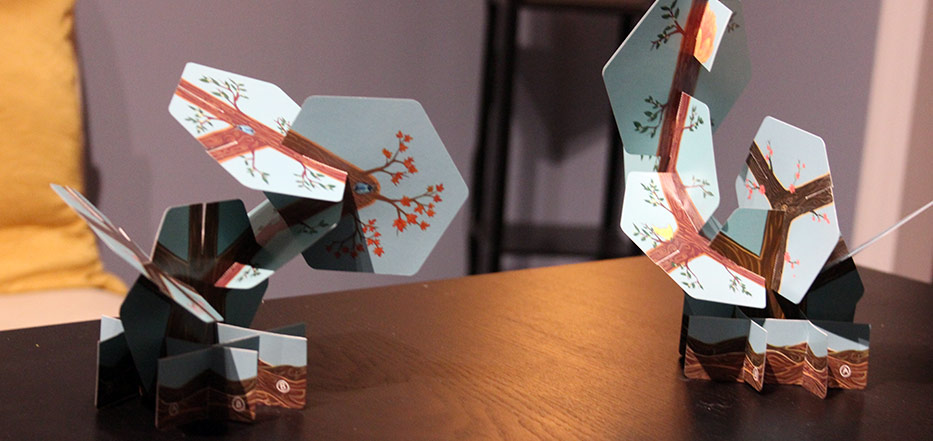I really enjoy a game with good table presence. There’s something special about a game that draws in people because they glance at something they don’t see every day. Tiny Trees from USC Games has left the world of 2D and has players building 3 dimensional trees in order to become the next demigod.
Up to 4 players start with a tree base that is built from a couple sturdy cards. In the middle of the table there are 3 stacks of branchlets and 8 flower cards. On your turn you’ll pick one of these items to add to your growing tree. There are lots of ways that you can grow the tree and it’s easy to find a branchlet that does what you want.

There are 3 varieties of tree branches that can show up in Tiny Trees. Cherry, Maple and Laurel. When you add a flower to a series of branches, you’ll score the branch type that shows up the most. For example, if you have 3 maple branches and 1 cherry branch, you’ll score 3 points for your maple branches. Some branches have bugs, birds or mushrooms on them which can score points for lifeforms. By collecting multiples of the same lifeform, your increasing your score for the end of the game.
Tiny Trees offers multiple ways to score points which I really enjoyed. If the tree branch that I needed wasn’t available on my turn, chances are that one of the branches had a lifeform on it so I would still continue scoring points. From our experience, scores usually hover in the teens so 2 or 3 points can make a big difference.

At the beginning of a game 2 blessing cards come out. These have unique ways for players to score points by accomplishing a goal or even interact with another players tree. I liked how this switched up the game a little. With 2 random cards each game, it can shift the strategy slightly or get players chasing a specific goal.
The game ends when two stacks of branchlets are gone or all of the flowers have been taken. There is definitely a little strategy when taking these flower cards. When you add them to your tree, that stops a line of branches. You want to have branches going in multiple directions so you can continue growing your tree. The variety of branches that come with the game feel really good.

Tiny Trees sets out to make a light family game that has a unique look but I struggled a little on the execution of building the tree. For myself, I was able to get the tree branches to fit into place and look pretty good. This definitely wasn’t the case for the kids. Each time our 13 and 14 year old played, they spent most of the game adjusing the tree because the cards wouldn’t sit correctly. This would be a big reason why I struggle to recommend this for a family with younger kids. You know what the tree should look like and it’s frustrating when the cards are not sitting just right.
You can tell that a lot of planning and care went into creating Tiny Trees. The variety of the branchlets will cause you to try something new depending on the choices available. The different scoring avenues bring variety to the game. When you get the cards to sit just right, you have a creation that you can be proud of.
Tiny Trees is a very accessible game that is quick to teach and looks really unique. If this sounds like a game that your family would enjoy, head over to their Kickstarter campaign today.
USC Games provided us with a prototype copy of Tiny Trees before their Kickstarter campaign. This in no way influenced our opinion of the game. Previews are a glimpse into an upcoming game with the pros and cons that we experienced prior to production of the game.





